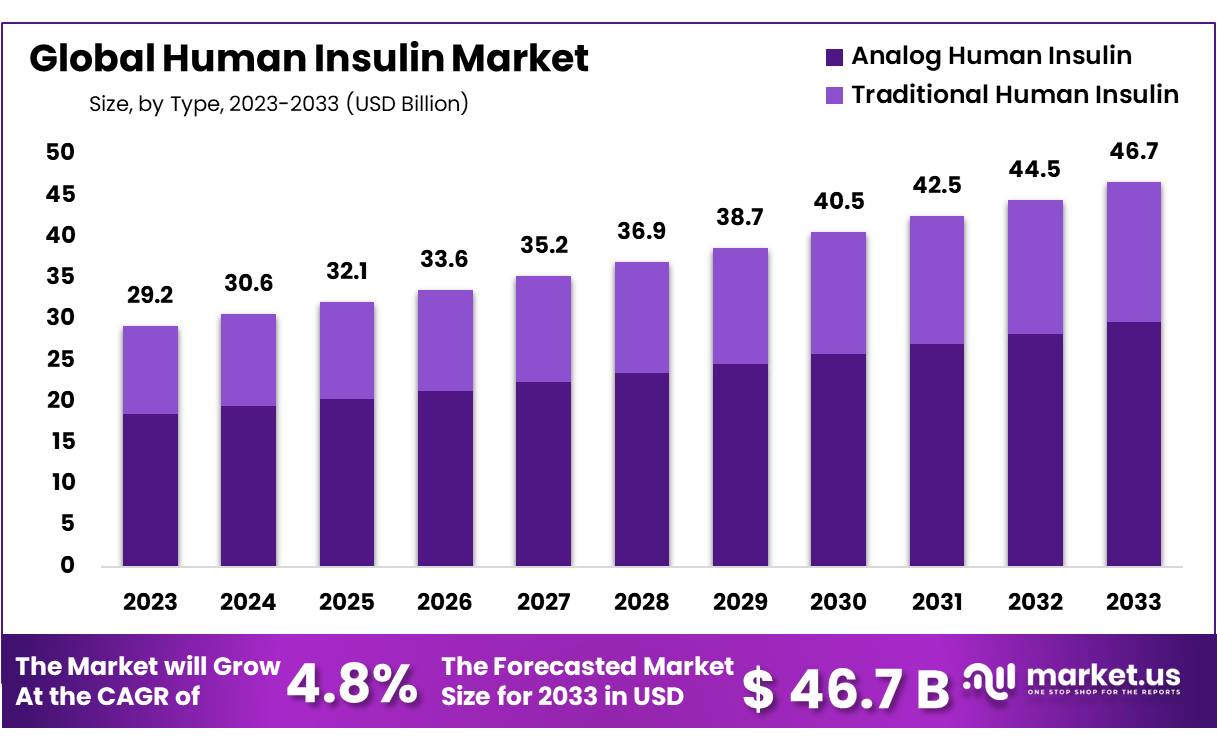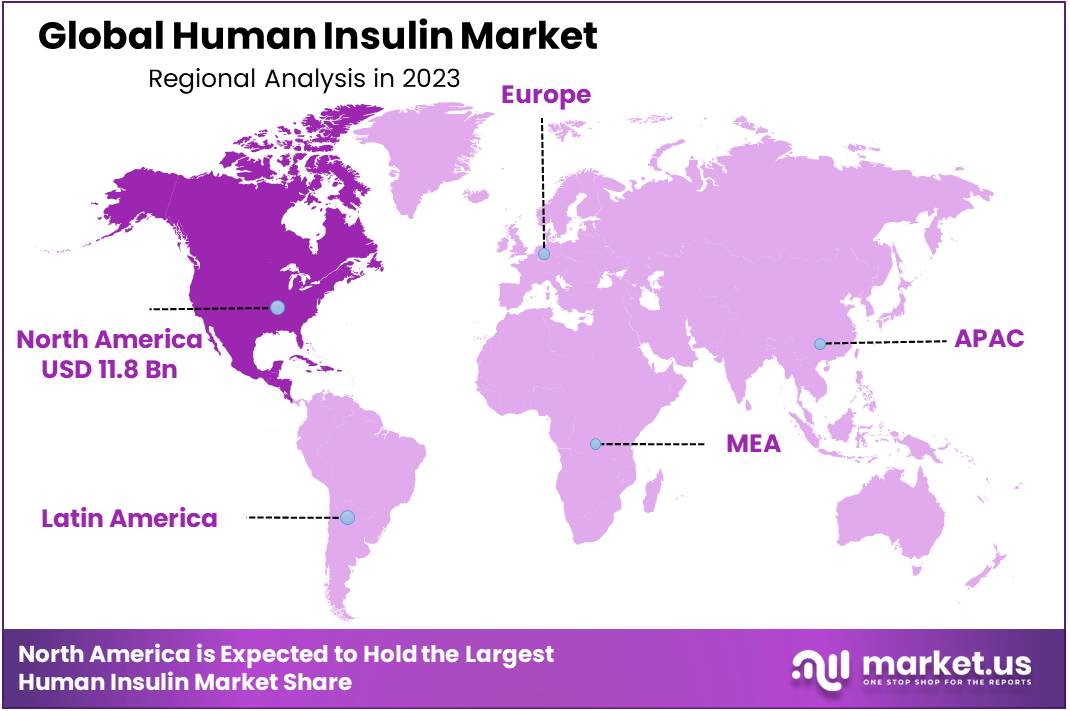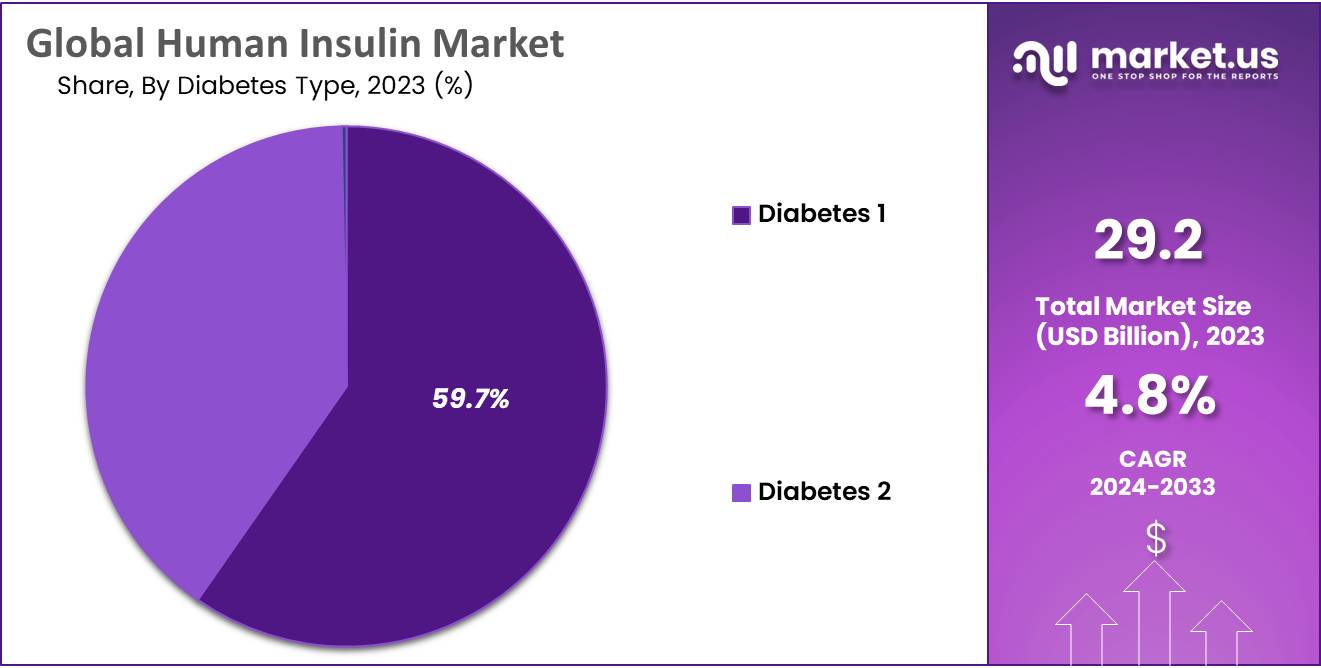New York, Feb. 12, 2024 (GLOBE NEWSWIRE) -- According to Market.us, the global Human Insulin Market size is forecasted to exceed USD 46.7 Billion by 2033, with a promising CAGR of 4.8% from 2024 to 2033.
Insulin, a peptide hormone secreted by the beta cells in the pancreas, plays a pivotal role in regulating glucose levels in the body by facilitating its absorption from the bloodstream. Its function is particularly crucial for individuals with compromised blood tissue and accompanying health complications such as diabetic retinopathy and diabetic nephropathy. In cases where the body's natural regulation of glucose becomes impaired, insulin administration becomes necessary for daily management.
The market for analog diabetic insulins is anticipated to witness growth in response to the escalating prevalence of diabetes, driving up demand for these specialized insulin formulations. As the number of diabetes patients continues to rise, the need for effective insulin therapies is expected to propel market expansion over the forecast period.
Want to Access the Statistical Data and Graphs, Request PDF Sample @ https://market.us/report/human-insulin-market/request-sample/

Key Takeaway
- In the insulin market's product type analysis, analog human insulin emerged as the dominant segment compared to traditional human insulin, owing to its superior treatment adherence, glycemic control, and lower risk of hypoglycemia. The segment secured a market share of 63.5% in 2023.
- In the application analysis, Type 1 Diabetes emerged as a segment poised for significant growth, driven by the escalating global prevalence of diabetes and the necessity for daily insulin injections to manage blood glucose levels. The segment claimed 59.7% of the market.
- Regarding distribution channels, hospital and retail pharmacies emerged as dominant players, with online pharmacies leading in revenue generation due to their accessibility and convenience. Hospital and retail pharmacies segment maintained their stronghold on the market and held a market share of 60.5%.
- Region wise, North America generated the most revenue for the market in 2023, with the market share of 40.7%.
Factors Affecting the Growth of the Human Insulin Market
- The human insulin market is experiencing robust growth driven by various factors. The launch of novel insulin products and the increasing prevalence of diabetes, particularly among the aging population, are primary drivers stimulating market expansion.
- Despite these drivers, the market faces restraints such as inadequate health funding and diagnostic limitations, particularly in emerging regions. However, significant opportunities arise from increasing investments in healthcare infrastructure in countries like Brazil, India, South Africa, and China, which are witnessing rapid growth in their healthcare industries.
- Moreover, notable trends such as the introduction of innovative insulin delivery systems and growing public awareness about insulin therapy are further fueling market growth. These trends collectively underscore the evolving landscape of the human insulin market and highlight the importance of meeting the growing demand for essential medical treatments like insulin across diverse demographic segments.
Top Trends in the Global Human Insulin Market
- The human insulin market is witnessing several notable trends that are driving its growth trajectory. One prominent trend is the increasing prevalence of diabetes globally, attributed to lifestyle choices, unhealthy dietary habits, and elevated stress levels. This rise in diabetes incidence contributes significantly to the growing demand for human insulin products worldwide. Additionally, the expanding geriatric population, known to be more susceptible to diabetes, further fuels market growth.
- Key players in the human insulin market are introducing innovative pen devices and safety pen needles, aimed at enhancing insulin administration safety and efficacy while reducing the risk of infection, injuries, and discomfort for patients. These advancements in insulin delivery systems contribute to the overall growth and development of the market.
- Furthermore, there is a noticeable trend of growing public awareness regarding the benefits of insulin therapy and heightened health consciousness among individuals. As awareness increases about the importance of managing diabetes effectively, more individuals are turning to insulin therapy as part of their diabetes management regimen. This shift in patient attitudes towards insulin treatment is driving market expansion and presenting new opportunities for industry players to meet the evolving needs of diabetic patients worldwide.
Market Growth
The human insulin market is poised for substantial growth driven by several key factors. The increasing prevalence of diabetes globally, coupled with a rising geriatric population, continues to fuel the demand for human insulin products. Technological advancements in insulin delivery systems, such as pen devices and safety pen needles, contribute to improved patient outcomes and enhanced convenience, further stimulating market growth.
Additionally, rising healthcare investments in emerging economies, alongside growing awareness about diabetes management and insulin therapy, present significant growth opportunities for market players. With a focus on expanding healthcare infrastructure and increasing access to diabetes treatment, particularly in regions like Asia Pacific and Latin America, the human insulin market is expected to experience robust growth in the coming years.
Macroeconomic Factors
Several macroeconomic factors influence the human insulin market dynamics. Economic stability and GDP growth directly impact healthcare expenditure, including spending on diabetes management and insulin therapy. Government healthcare policies, regulatory frameworks, and reimbursement systems play a crucial role in shaping market dynamics, affecting accessibility and affordability of insulin products. Additionally, demographic trends such as aging populations, urbanization, and lifestyle changes contribute to the increasing prevalence of diabetes, driving demand for human insulin.
Technological advancements and investments in healthcare infrastructure further influence market growth, facilitating innovation in insulin delivery systems and improving patient outcomes. Moreover, fluctuations in currency exchange rates and trade policies impact the pricing and availability of insulin products, shaping market dynamics on a global scale.
Regional Analysis
North America commands the largest share in the human insulin market, driven by several key factors contributing to its dominance. The region benefits from the presence of major insulin manufacturers and robust competition among industry players. Moreover, the increasing prevalence of both diabetes type 1 and type 2 fuels the demand for insulin products in North America, propelling market growth. Following North America, Europe emerges as the second-largest region in the human insulin market, supported by its growing healthcare sector and the presence of prominent market players.
Meanwhile, the Asia Pacific region is expected to exhibit the highest compound annual growth rate (CAGR) during the forecast period. This growth can be attributed to the high incidence of diabetes among the population in this region, driven by factors such as poor dietary habits and unhealthy lifestyles. The rise in high-risk diabetes patients underscores the urgent need for insulin therapy, thereby boosting market expansion across Asia Pacific.
Conversely, the markets in Latin America and the Middle East Africa region are anticipated to experience slower growth compared to other regions. However, countries in Latin America, including Mexico and Brazil, are expected to drive demand for insulin owing to the increasing prevalence of diabetes and improving access to healthcare services. Overall, the global human insulin market reflects regional variations in growth rates, shaped by factors such as disease prevalence, healthcare infrastructure, and socio-economic conditions.
Uncover the actionable insights tailored to your business strategy. Request our brochure to learn more https://market.us/report/human-insulin-market/#inquiry

Scope of the Report
| Report Attributes | Details |
| Market Value (2023) | USD 29.2 Billion |
| Forecast Revenue 2033 | USD 46.7 Billion |
| CAGR (2024 to 2033) | 4.8% |
| North America Share | 40.7% |
| Base Year | 2023 |
| Historic Period | 2018 to 2022 |
| Forecast Year | 2024 to 2033 |
Market Drivers
The launch of novel insulin products stands out as a primary driver stimulating growth in the insulin market. The aging population, particularly among diabetes patients, has seen a significant uptick, a trend expected to continue in the forthcoming years. With a substantial portion of the population affected by type 1 diabetes, there's a consistent demand for insulin to maintain glycemic control on a daily basis. This universal demand for human insulin is a key factor propelling market growth throughout the forecast period.
Additionally, the market is witnessing a surge in the introduction of new insulin products globally, reflecting a strategic focus among companies to develop innovative insulin drugs aimed at capturing larger market shares within the human insulin market. These trends collectively contribute to the dynamic expansion and evolution of the insulin market landscape.
Market Restraints
The growth of the insulin market faces significant restraints primarily stemming from the lack of health funding and diagnostic limitations. While the COVID-19 pandemic spurred demand growth for insulin, especially with the adoption of new products and advanced technologies, emerging and developing regions faced constraints due to inadequate funding. Moreover, the high cost associated with diagnostics and treatment poses a challenge to market expansion, particularly in regions with a significant population of low-income individuals unable to afford these expenses.
Inadequate funding in healthcare systems hampers accessibility to essential treatments, including insulin, exacerbating the challenge of affordability for many individuals. Additionally, the absence of comprehensive refund mechanisms further compounds the issue, discouraging individuals from seeking necessary diagnosis and treatment for diabetes. As a result, the limited accessibility to affordable healthcare and low rates of diagnosed diabetes cases curtail the demand for human insulin globally, thus impeding the anticipated growth trajectory of the market during the forecast period.
Market Opportunities
The human insulin industry presents significant opportunities driven by the increasing investments in healthcare infrastructure and facilities, particularly in emerging economies like Brazil, India, South Africa, and China. These nations are witnessing rapid growth in their healthcare industries, propelled by factors such as a growing geriatric population, rising per capita incomes, increasing patient volumes, and heightened awareness among individuals regarding healthcare needs.
Governments in these economies are ramping up investments to bolster healthcare facilities and infrastructure, recognizing the importance of addressing the healthcare needs of their populations. Given the wide-ranging applications of human insulin products in various healthcare settings, the surge in investments in the healthcare industry is poised to create favorable growth prospects in the human insulin market. This trend underscores the evolving landscape of healthcare delivery and underscores the importance of meeting the growing demand for essential medical treatments like insulin across diverse demographic segments.
Access Now for Quick Delivery | Buy Our Premium Research Report https://market.us/purchase-report/?report_id=28643
Report Segmentation of the Human Insulin Market
Type Insight
In the product type analysis of the insulin market, analog human insulin emerged as the dominant segment compared to traditional human insulin. Analog insulin's superiority lies in its enhanced treatment adherence and glycemic control, along with a lower risk of hypoglycemia compared to traditional insulin formulations. Additionally, analog insulin demonstrates rapid and consistent action in managing diabetes. Consequently, analog insulin has witnessed heightened demand in recent years, bolstered further by the introduction of novel insulin formulations. The segment claimed a market share of 63.5%. Conversely, traditional human insulin is anticipated to exhibit a lower compound annual growth rate (CAGR) compared to analog insulin, primarily due to its slower adoption rate among patients.
Diabetes Type Insight
In the application analysis of the insulin market, Type 1 Diabetes remained as a segment poised for significant growth, primarily attributed to the escalating prevalence of diabetes worldwide. The segment claimed a market share of 59.7%. Patients with Type 1 Diabetes require daily insulin injections to manage blood glucose levels, driving the demand for insulin products within this segment. Conversely, the Type 2 Diabetes segment is expected to experience slower growth compared to Type 1 Diabetes patients. Type 2 diabetes patients typically receive human insulin prescriptions when previous treatments have proven ineffective. With the global increase in the risk of developing Type 2 diabetes, driven by various lifestyle and environmental factors, the Type 2 Diabetes segment is anticipated to witness steady growth throughout the forecast period.
Distribution Channel Insight
In the distribution channel analysis, the market is classified into hospital pharmacies, retail pharmacies, and online pharmacies. Among these, hospital pharmacies generated the most revenue for the market and claimed 60.5% market share. Online pharmacies are expected to lead in revenue generation within the human insulin market, particularly due to the presence of major online retailers such as Amazon and Walmart venturing into the online pharmacy sector. The accessibility and convenience offered by online platforms, coupled with increasing awareness about medications and the introduction of more affordable insulin products, contribute to the growth of the online pharmacy segment.
Recent Development of the Human Insulin Market
- In July 2023, The US Food and Drug Administration (FDA) issued a total of eight observations for various units at Biocon Sdn Bhd, Malaysia, a subsidiary of Biocon Biologics. Among these, six observations were related to the drug substance, drug product units, and quality control laboratories, while the remaining two observations were for the delivery devices unit.
- In November 2023, Novo Nordisk has made the decision to discontinue Levemir, its basal insulin containing insulin detemir, used for managing glycemic control in adults and children with diabetes mellitus. While the company plans to continue supplying Levemir vials and the Levemir FlexPen to wholesalers until the discontinuation dates and while supplies last, they anticipate potential supply disruptions leading up to the full product discontinuation by the end of 2024.

Market Segmentation
By Type
- Analogue Human Insulin
-
- Long-acting
- Fast-acting
- Premix
- Traditional Human Insulin
-
- Long-acting
- Fast-acting
- Slow-acting
- Premix
By Diabetes Type
- Diabetes 1
- Diabetes 2
By Distribution Channel
- Hospital Pharmacy
- Retail Pharmacy
- Online Pharmacy
By Geography
North America
- US
- Canada
Europe
- Germany
- France
- The UK
- Spain
- Italy
- Russia
- Netherland
- Rest of Europe
Asia Pacific
- China
- Japan
- South Korea
- India
- New Zealand
- Singapore
- Thailand
- Vietnam
- Rest of APAC
Latin America
- Brazil
- Mexico
- Rest of Latin America
Middle East & Africa
- South Africa
- Saudi Arabia
- UAE
- Rest of MEA
For a better understanding, refer to this sample report, which includes corresponding tables and figures@ https://market.us/report/human-insulin-market/request-sample/
Competitive Landscape
New entrants and emerging players in the human insulin market are actively pursuing diverse strategic initiatives to expand their presence in foreign markets. These companies are prioritizing the enhancement of their operational capabilities and research and development (R&D) infrastructure to bolster their competitive edge. Moreover, they are leveraging investments, mergers, and acquisitions to diversify their product portfolios and introduce innovative offerings to the market.
In response to evolving consumer preferences and market trends, human insulin market players are also adopting dynamic marketing strategies. One prominent approach involves raising awareness about products formulated with natural ingredients, which resonates with health-conscious consumers and drives the growth of targeted products. By embracing these multifaceted strategies, companies in the human insulin market aim to strengthen their market position, capture new opportunities, and meet the evolving needs of consumers in both domestic and international markets.
Market Key Players
- Novo Nordisk N\S
- Eli Lilly and Company
- Sanofi
- BIOCON
- Tonghua Dongbao Pharmaceuticals Ltd.
- Julphar
- Wockhardt
- Other key players
Explore More Life Science Market Research Reports
- Innovative Materials and Technologies Shape the Future of Medical Tubing Market
- Healthcare CRM Market is expected to hit USD 45 Billion by 2032 at a CAGR of 13.6 % – According to Market.Us
- Revolutionizing Dentistry: Dental 3D Printing Market Gains Momentum
- Vaccine Adjuvants Market size is expected to be worth around USD 1,134.7 Million by 2022 from USD 3,933.7 Million in 2032
- Neurostimulation Devices Market: A Beacon of Hope for Chronic Pain Management
- Aesthetic Medicine Market size is expected to be worth around USD 571.6 Billion by 2033, from USD 130.7 Billion in 2023
- Pharmaceutical Filtration Market size is expected to be worth around USD 28.7 billion by 2032, from USD 12.8 billion in 2023
- Urgent Care Center Market size is expected to be worth around USD 37.3 Billion by 2032, from USD 24.3 Billion in 2023
- Nutrigenomics Market Size is anticipated to reach approximately USD 2,171.8 million by 2033, exhibiting substantial growth from USD 612.2 million in 2023
- Phytosterols Market Size is anticipated to reach a valuation of approximately USD 2,514 million by 2033
About Us:
Market.US (Powered by Prudour Pvt Ltd) specializes in in-depth market research and analysis and has been proving its mettle as a consulting and customized market research company, apart from being a much sought-after syndicated market research report-providing firm. Market.US provides customization to suit any specific or unique requirement and tailor-makes reports as per request. We go beyond boundaries to take analytics, analysis, study, and outlook to newer heights and broader horizons.
Follow Us on LinkedIn
Our Blog:
